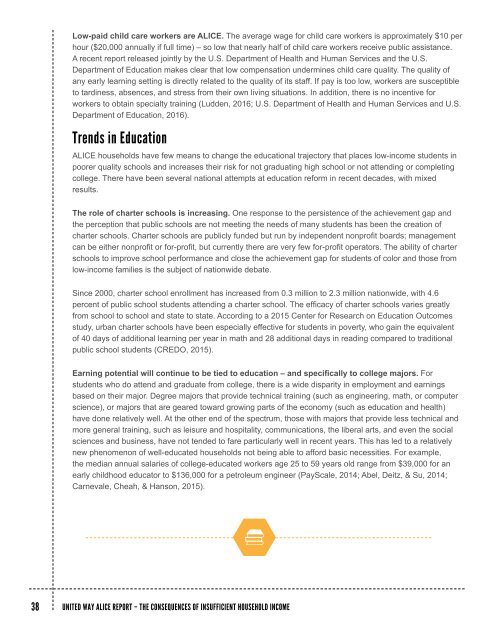The Consequences of Insufficient Household Income
This new Consequences of Insufficient Household Income report provides a deeper level of understanding of the choices that ALICE and poverty-level families across the country make when they do not have enough income or assistance to afford basic necessities, and the consequences of those choices.
This new Consequences of Insufficient Household Income report provides a deeper level of understanding of the choices that ALICE and poverty-level families across the country make when they do not have enough income or assistance to afford basic necessities, and the consequences of those choices.
Create successful ePaper yourself
Turn your PDF publications into a flip-book with our unique Google optimized e-Paper software.
Low-paid child care workers are ALICE. <strong>The</strong> average wage for child care workers is approximately $10 per<br />
hour ($20,000 annually if full time) – so low that nearly half <strong>of</strong> child care workers receive public assistance.<br />
A recent report released jointly by the U.S. Department <strong>of</strong> Health and Human Services and the U.S.<br />
Department <strong>of</strong> Education makes clear that low compensation undermines child care quality. <strong>The</strong> quality <strong>of</strong><br />
any early learning setting is directly related to the quality <strong>of</strong> its staff. If pay is too low, workers are susceptible<br />
to tardiness, absences, and stress from their own living situations. In addition, there is no incentive for<br />
workers to obtain specialty training (Ludden, 2016; U.S. Department <strong>of</strong> Health and Human Services and U.S.<br />
Department <strong>of</strong> Education, 2016).<br />
Trends in Education<br />
ALICE households have few means to change the educational trajectory that places low-income students in<br />
poorer quality schools and increases their risk for not graduating high school or not attending or completing<br />
college. <strong>The</strong>re have been several national attempts at education reform in recent decades, with mixed<br />
results.<br />
<strong>The</strong> role <strong>of</strong> charter schools is increasing. One response to the persistence <strong>of</strong> the achievement gap and<br />
the perception that public schools are not meeting the needs <strong>of</strong> many students has been the creation <strong>of</strong><br />
charter schools. Charter schools are publicly funded but run by independent nonpr<strong>of</strong>it boards; management<br />
can be either nonpr<strong>of</strong>it or for-pr<strong>of</strong>it, but currently there are very few for-pr<strong>of</strong>it operators. <strong>The</strong> ability <strong>of</strong> charter<br />
schools to improve school performance and close the achievement gap for students <strong>of</strong> color and those from<br />
low-income families is the subject <strong>of</strong> nationwide debate.<br />
Since 2000, charter school enrollment has increased from 0.3 million to 2.3 million nationwide, with 4.6<br />
percent <strong>of</strong> public school students attending a charter school. <strong>The</strong> efficacy <strong>of</strong> charter schools varies greatly<br />
from school to school and state to state. According to a 2015 Center for Research on Education Outcomes<br />
study, urban charter schools have been especially effective for students in poverty, who gain the equivalent<br />
<strong>of</strong> 40 days <strong>of</strong> additional learning per year in math and 28 additional days in reading compared to traditional<br />
public school students (CREDO, 2015).<br />
Earning potential will continue to be tied to education – and specifically to college majors. For<br />
students who do attend and graduate from college, there is a wide disparity in employment and earnings<br />
based on their major. Degree majors that provide technical training (such as engineering, math, or computer<br />
science), or majors that are geared toward growing parts <strong>of</strong> the economy (such as education and health)<br />
have done relatively well. At the other end <strong>of</strong> the spectrum, those with majors that provide less technical and<br />
more general training, such as leisure and hospitality, communications, the liberal arts, and even the social<br />
sciences and business, have not tended to fare particularly well in recent years. This has led to a relatively<br />
new phenomenon <strong>of</strong> well-educated households not being able to afford basic necessities. For example,<br />
the median annual salaries <strong>of</strong> college-educated workers age 25 to 59 years old range from $39,000 for an<br />
early childhood educator to $136,000 for a petroleum engineer (PayScale, 2014; Abel, Deitz, & Su, 2014;<br />
Carnevale, Cheah, & Hanson, 2015).<br />
38 UNITED WAY ALICE REPORT – THE CONSEQUENCES OF INSUFFICIENT HOUSEHOLD INCOME




